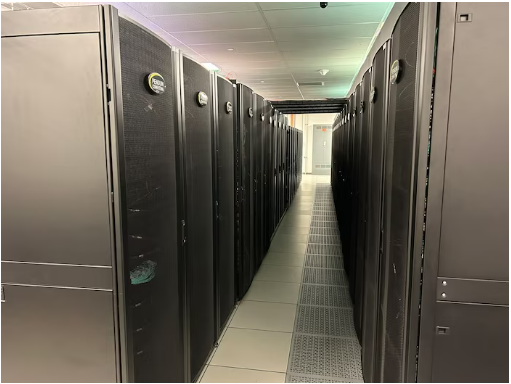
Raider supercomputer (credit: AFRL)
WRIGHT-PATTERSON AIR FORCE BASE, Ohio – The Air Force Research Laboratory (AFRL) has announced the installation of a supercomputer, named the Raider.
The system is named in honor of the Doolittle Raiders of World War II and delivers about 12 petaFLOPS of compute power, ranking it in the vicinity of the 50th most powerful system in the world, according to the TOP500 ranking of HPC systems.
According to an announcement this month from AFRL Public Affairs, the system is part of the Department of Defense’s High Performance Computing Modernization Program (DOD HPCMP) and will serve the Air Force, Army and Navy. While the announcement does not name the system vendor, it includes a photo with the Penguin Solutions logo on the system’s cabinet doors.
AFRL Public Affairs did not share many system details, but information disclosed in May 2022 by the AFRL DoD Supercomputing Resource Center said the system contract was awarded to Penguin and that it will be powered by AMD CPUs and NVIDIA GPUs totaling 189,000 cores. However, that information also estimated the system’s power at 6 petaFLOPS, so it’s unclear if the system specs released last year remain valid.
Two years ago, Penguins Solutions was awarded two DOD HPCMP contracts worth $68 million to deliver Penguin TrueHPC supercomputing platforms, plus managed services and high-performance storage.
AFRL said its previous supercomputer, Thunder, installed in 2015, delivered 3.1 petaFLOPS. More recently, the AFRL’s Digital Capabilities Directorate placed an order for the next two supercomputers to be delivered in 2024, the TI-23 Flyer and TI-23 Raven, which are expected to deliver 14 petaFLOPS. Flyer and Raven will support the unclassified and classified systems, respectively, AFRL said.
 “The fuel of our digital transformation is our compute capacity,” said AFRL Chief Information Officer and Digital Capabilities Directorate Alexis Bonnell. “Not every mission of AFRL, the Air Force, Space Force or DOD is appropriate for cloud. Outpacing the adversary often means out-racing them, ensuring our data can move faster, be analyzed more rapidly and gain insight driven advantage to keep the fight unfair.”
“The fuel of our digital transformation is our compute capacity,” said AFRL Chief Information Officer and Digital Capabilities Directorate Alexis Bonnell. “Not every mission of AFRL, the Air Force, Space Force or DOD is appropriate for cloud. Outpacing the adversary often means out-racing them, ensuring our data can move faster, be analyzed more rapidly and gain insight driven advantage to keep the fight unfair.”
Speed and modeling is a large part of the outcome.
“What we’re trying to do with the digital transformation is take some of these workloads that were done in testing … We’re now able to simulate, in which case we can do the testing cheaper, faster,” said Bryon Foster, division chief, AFRL’s Digital Capabilities Directorate. “In some ways, we can do things in simulations that you could never do in a physical testing environment.”
One example is hypersonic vehicles that travel too fast to test on a range.
DOD has five DSRCs, and Wright-Patterson Air Force Base is the largest Air Force DSRC, according to Foster. Because it is a DOD resource, contractors, civilians, military and other organizations with a DOD sponsor all have access to the supercomputer.
Foster explained that the modeling and simulations resulted in a higher level of accuracy. For example, the Navy previously ran simulations at lower levels of accuracy with the hardware they had access to, however, the Raider was able to acclerate the same project from six months to three weeks.




